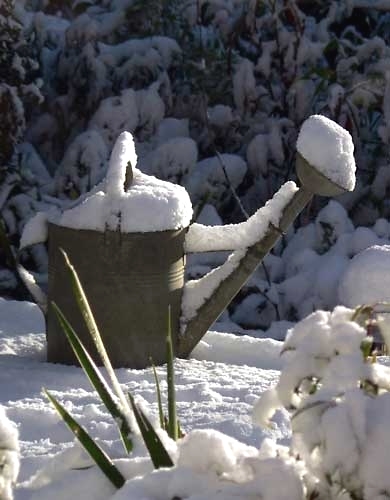
If you provide the needed conditions, some spring flowers can grow inside your home even if outside is still snowing. Such flowers are hyacinths, primroses, tulips, crocuses, daffodils, snowdrops and even May-lilies. Other plants, such as azalea and cyclamen, remind us of spring with their bright colours.
The following tips will help you with the process of growing spring flowers in winter:
- Regularly clean the faded blossoms of the azalea, in order to make space for the new ones.
- The room, in which the hyacinth is growing, should be ventilated every day, because the flower loves the fresh air. Besides that, the pot should have a sunny spot, where the hyacinth will get its needed daily dose of sunlight.

- If you want to enjoy the primrose’s blossoms longer, you will have to keep it an a low pot and water it on a regular basis.
- Not a lot of people are familiar with the fact, that it is possible to grow snowdrops on the balcony, despite the cold weather outside. If you want to try this idea out, you can plant the snowdrops in a small wooden box. Make sure to nurture them regularly once they start growing. Don’t worry about the low temperatures outside, because the flowers won’t be damaged.

- Nowadays, you can find May-lilies in many flower shops. The May-lily likes sunny places, fresh air and not very high room temperatures. If you have small children or pets at home, you should be extra careful, because the May-lily is poisonous.
- Another good idea for brightening your home during winter, is to make your own amazing flower arrangements. Martha Stewart has several marvellous suggestions, which you can check out here.
Enjoy the bright and beautiful colours of spring flowers!
]]>
Water the Plants Rarely
Plants also hibernate during winter and if you water them too often, you will interrupt their natural cycle and they will think it’s time to become active again. Have in mind that garden plants may not survive the conditions inside your home, so better leave them outside. The plants that usually grow more during winter, should be watered regularly and more often than the others.

Clean off the Dust
If you want to enjoy the beauty of your indoor plants longer, you should remove the dust from their leaves on a weekly basis. Dust limits the access of fresh air and sunlight, which are needed for the normal life of a plant.
Look up in a book or in the Internet which of your flowers are fond of warm baths. Rinse them with warm (not hot) water and they will express their gratitude with beautiful blossoms and healthy leaves.

Find New Seeds
It’s a good idea to spend some of the cold winter days researching what new seeds you will need for the next gardening season. You can also equip your garden with new pots in different colours and sizes, which will make your yard even more beautiful. Another suggestion is to buy ordinary pots and then decorate them according to your taste.

Clean the Gardening Tools
Winter is the best time to perform an overall cleaning of your gardening tools and get them ready for spring. Remove all the dirt and dust, that they have gathered during the year. Rinse and dry them off completely to avoid rusting. You can even apply linseed oil on them for better protection.
Enjoy Your Garden
The experienced gardeners advise to avoid walking over the snowy lawn, because this can damage the soil. But you can still enjoy your garden during the winter – just take a chair outside and grab a blanket, a nice book or a hot cup of tea.

Although, winter is not that colourful as spring and summer, you can still find the beauty in it and admire it.
]]> If you wish to grow your own vegetables in your backyard during the spring, keep reading this article as we have listed a quick tutorial on how to grow your own vegetables.
If you wish to grow your own vegetables in your backyard during the spring, keep reading this article as we have listed a quick tutorial on how to grow your own vegetables.
Before you start planting make sure that you gardening tools are crystal clean. If they are not take them to professional gardening tool cleaners based in Bexley. In terms of cleaners, Bishopsgate also has a wide array of firms to choose from.
Lettuce – Lettuces are a bit hard to grow during the spring as they need some extra protection. However losing some time to grow lettuces during the spring is well worth as the tastiest lettuces are grown during the spring. The ideal weather to grown lettuces in the spring are the cool and wet days.
Asparagus – Asparagus is a sort of perennial vegetable. If you do not know what a perennial vegetable is, a perennial vegetable is a type of vegetable that you can plant once and harvest for many years to come. The best time to cultivate your asparagus plantation is during the spring as it is during the spring that this vegetable is tender and tasty. Many people begin to eat asparagus only after they have tried fresh spring asparaguses.
Peas – If you wish to grow peas in your garden make sure to plant them during the month of April, as April planted peas tend to grown faster than March planted peas and tend to be tastier than peas planted during the months of May. Keep in mind that peas do not like heat so there is no point of planting peas after mid May.
Rhubarb – Rhubarb is like the asparagus is a perennial vegetable that is very easy to grow. If you plant your rhubarb properly you can harvest tasty rhubarbs each spring to come, just make sure to control the growth of the rhubarb.
Spinach – Spinach is best grown when the weather is cool. Keep in mind that spinach grown very rapidly so you won’t need to wait a long time before you can enjoy your garden grown spinach.
]]>



